nForce 500: nForce4 on Steroids?
by Gary Key & Wesley Fink on May 24, 2006 8:00 AM EST- Posted in
- CPUs
Improved Feature: Control Panel / nTune 5.0
One of most interesting features of the nForce 500 launch is the revamped control panel and nTune 5.0 performance applications. NVIDIA has combined all of their various program applets into an integrated control panel to provide a common user interface, a common interface that certainly makes it easier for the user to control the various functions of the board and video (NVIDIA based) from a central point. |
| Click to enlarge |
The new control panel offers configuration sections for 3D Settings for NVIDIA GPUs, Display settings, Networking options, Performance, System Stability testing, Storage, and Video/Television settings. The majority of information contained in each section will already be familiar to those with nForce4 boards, only with the same look and feel as the other control panels as well as some extended configuration options.
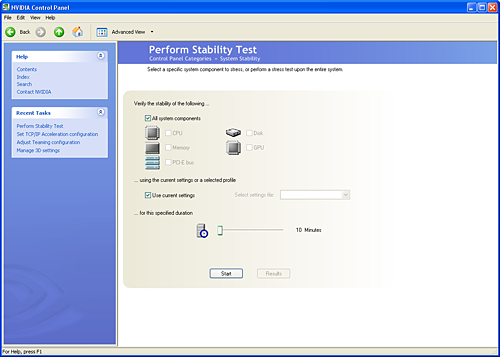 |
| Click to enlarge |
A new application being featured is a System Stability test program that will run application level stress testing on the platform or on an individual component for a user specified amount of time. We found the application would generally fail settings that were a little more conservative than we utilize in stress testing, but it is nice to know the program will err on the safe side.
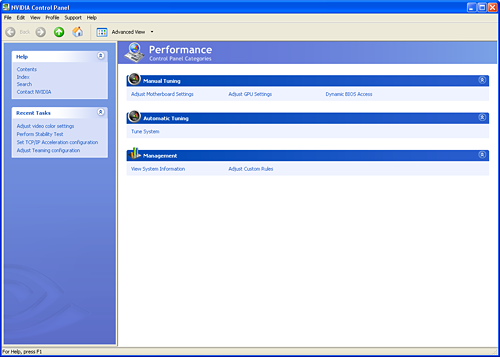 |
| Click to enlarge |
The most interesting application is nTune 5.0 that can be found by clicking the Performance icon. nTune has undergone a complete transform and now includes the ability to dynamically write a significant number of performance settings directly to the BIOS without requiring a reboot. You also have the option for letting the system dynamically create an overclocking profile and automatically adjust the BIOS settings under the Automatic Tuning section.
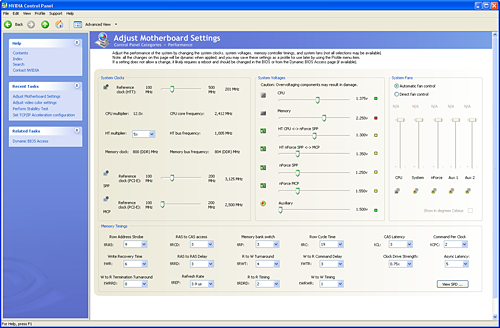 |
| Click to enlarge |
The Adjust Motherboard Settings section is certainly the most interesting of the performance oriented applets as changes in these fields are dynamically written to the BIOS. The settings can be saved in profiles that can be loaded within Windows without having to reset the system and enter the BIOS. This can help with situations where optimal settings for games might differ from those for audio/video playback. The system also allows for automatic or direct fan speed control on supported board headers.
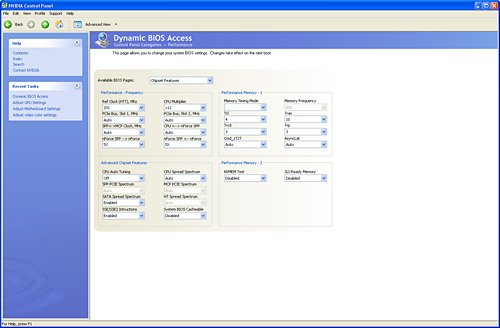 |
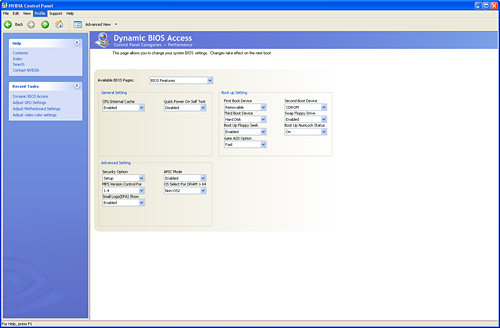 |
| Click to enlarge |
The Dynamic BIOS Access section offers the ability to change BIOS setting in four different categories that will take effect on reboot. The two sections not displayed are for power management and peripheral settings.
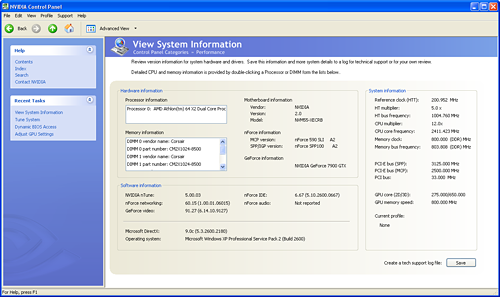 |
| Click to enlarge |
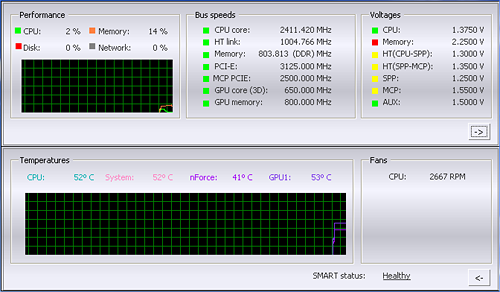 |
NVIDIA also includes a System Information utility along with a Windows based monitoring application. Overall, the polished look, feel, and operation of the new control panel along with the performance improvements offered in nTune 5.0 has raised the bar for user enhancements offered by the core logic and motherboard suppliers.










64 Comments
View All Comments
Olaf van der Spek - Wednesday, May 24, 2006 - link
<quote>These devices can be configured in RAID 0, 1, 0+1, and 5 arrays. There is no support for RAID 10.</quote>That's probably because there's effectively no difference between 1+0 and 0+1 on a good controller.
Olaf van der Spek - Wednesday, May 24, 2006 - link
Doesn't this require support from the modem/router too?
The delay (usually) happens in the modem and not in the network card.
Zoomer - Saturday, May 27, 2006 - link
No, because you make the bottleneck your network card, instead of the modem. :)There will be a slight loss of throughput. Read some QoS articles. lartc.org is also a good resource. I bet it's the same principle. ;)
Trisped - Wednesday, May 24, 2006 - link
<quote>Multiple computers can to be connected simultaneously </quote>http://www.anandtech.com/cpuchipsets/showdoc.aspx?...">http://www.anandtech.com/cpuchipsets/showdoc.aspx?...
take out the "to"
Gary Key - Wednesday, May 24, 2006 - link
Thanks, it is corrected.....Googer - Wednesday, May 24, 2006 - link
When benchmarking core logic it's should be a high priority to measure I/O performance, since that is the primary job of any AMD Chipset.Where are the HDD, Network, Audio, and R.A.I.D. benchmarks?
Gary Key - Wednesday, May 24, 2006 - link
I answered above but we will have full benchmarks in the actual motherboard articles. Our efforts in the first three days was to prove out the platform and features that were added or changed (still doing it, feels weird to be up almost 72 hours). In answer to your question-
Foxconn Board
Network-
Throughput - 942 Gb/s
CPU utilization - 14.37% (with TCP/IP offload engine on), near 30% off.
HDD/RAID
No real difference compared to nF4 as we stated. The numbers are within 1% of each other. The interesting numbers will be in our ATI SB600 comparison.
Audio-
Dependent on the codec utilized in each motherboard, the RealTek ALC883 used in most of them have the same numbers as the nF4 boards. The only difference is the new 1.37 driver set we used. It will be interesting in the comparison as Asus went back to ADI for HDA.
Pirks - Wednesday, May 24, 2006 - link
That's why AT is my favorite review site - 'cause you're really crazy bunch :-) Just don't ruin yourself completely, we need you!Gary Key - Wednesday, May 24, 2006 - link
The ending should read NF4 Intel or ATI/Uli AMD boards. Where is that edit function? Hit enter too soon. :)Gary Key - Wednesday, May 24, 2006 - link
They will be in our roundup comparison and ATI AM2 articles.